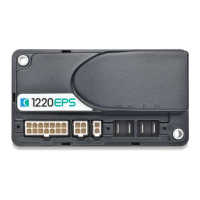Curtis 1220 Manual, Rev. C
33
Continuing with the commissioning procedures will require the steer motor
to turn, so you will have to enable the steer interlock (interlock = On).
e vehicle drive wheels should continue to be jacked up o the ground so
they can spin freely and steer freely from stop to stop. Enabling the steer
interlock can result in erratic movement of the steer motor.
4
Position Feedback Device Setup (see pages 14–16)
Manually enable the steer interlock, so that the 1220 will begin steering; the
traction interlock can remain O. Verify that the 1220 interlock is now On
(Monitor
» Inputs&Outputs » Interlock Switch). If Interlock Switch = O, resolve
the fault condition that is causing this, change the interlock input to the steer
controller, or adjust the Interlock Type parameter (Vehicle Conguration
»
Interlock Type) until the Interlock Switch variable = On.
Your position feedback device will be a potentiometer (using pin J1-11) or a
motor encoder with a Home switch (using pins J1-2 and J1-9 for the motor
encoder and J3-2 for the Home switch).
Set the
Position Feedback Device and Redundant Input parameters to match
your input type:
Position Feedback Device Type and Redundant Input Type
0 = Analog pot. Off = Single input.
1 = Polarity encoder. On = Redundant inputs.
2 = Quadrature encoder.
Use the appropriate setup procedure for the type of device you have chosen.
Setup for Analog Pot feedback (see page 15)
a. Use the tiller to move the steered wheel to the Left stop and observe the
voltage shown in the Monitor » Position Feedback » Position Analog 1 Input
variable. Set the
Position Left Stop parameter to the observed voltage.
b. Similarly, move the steered wheel to the center and observe the voltage
shown in the Position Analog 1 Input variable. Set the parameter Position Center
parameter to the observed voltage.
c. Finally, move the steered wheel to the Right stop and again observe the
voltage shown in the Position Analog 1 Input variable. Set the parameter Position
Right Stop parameter to the observed voltage.
d. Set the two fault parameters (Position Fault Min and Position Fault Max). Set
these to voltages that will not be reached during normal operation, but will
be reached if the steer position feedback becomes faulty (e.g., should there
be an open or short circuit).
e Position Fault Min setting must be below the minimum voltage seen on
Position Analog 1 Input when steered to the maximum left or right positions.
e Position Fault Max setting must be above the maximum voltage seen on
Position Analog 1 Input when steered to the maximum left or right positions.
5 — COMMISSIONING
+
IMPORTANT

